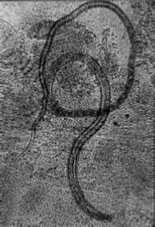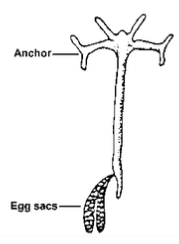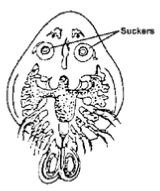Fish Parasites P3
Flagellates Continued:
Flagellated protozoans are small parasites that can infect fish externally and internally. They are characterized by one or more flagella that cause the parasite to move in a whip-like or jerky motion. Because of their small size, their movement, observed at 200 or 400 x magnification under the microscope, usually identifies flagellates. Common flagellates that infest fish are given below.
Digenean Trematodes:
Digenean trematodes have a complex life cycle involving a series of hosts (Figure 18). Fish can be the primary or intermediate host depending on the digenean species. They are found externally or internally, in any organ. For the majority of digenean trematodes, pathogenicity to the host is limited.
The life stage most commonly observed in fish is the metacercaria, which encysts in fish tissues (Figure 19). Again, metacercaria that live in fish rarely cause major problems. However, in the ornamental fish industry, digenetic trematodes from the family Heterophyidae, have been responsible for substantial mortalities in pond-raised fish. These digeneans become encysted into gill tissue and respiratory distress is eminent.

Figure 18

Figure 19
Another example of a metacercaria that could cause problems in cultured fish is the genus Posthodiplostonum or the white grub. This has caused mortalities in bait fish, but usually the only negative effect is reduced growth rate, even when the infection rate is high. In cases where mortalities occur, there are unusually high numbers in the eye, head, and throughout the visceral organs.
Another fluke is Clinostonum, often called yellow grub. It is a large trematode and although it does not cause any major problems for fish, it is readily seen and will make fish unmarketable for aesthetic reasons.
The best control of digenean trematodes is to break the life cycle of the parasite. Elimination of the first intermediate host, the freshwater snail is often recommended. Copper sulfate in ponds has been used with limited success and is most effective against snails when applied at night, due to their nocturnal feeding activity. For Florida ornamental fish growers a chemical for snail control, Bayluscide, is available. This is a Restricted Use Pesticide and access to it is controlled.
Nematodes:
Nematodes, also called roundworms, occur worldwide in all animals. They can infect all organs of the host, causing loss of function of the damaged area. Signs of nematodiasis include anemia, emaciation, unthriftiness and reduced vitality. Three common nematodes affecting fish are described.
Camillanus:
Camillanus is easily recognized as a small thread-like worm protruding from the anus of the fish. Control of this nematode in non-food fish is with fenbendazole, a common antihelminthic. Fenbendazole can be mixed with fish food (using gelatin as a binder) at a rate of 0.25% for treatment. It should be fed for three days, and repeated in three weeks.

Figure 20

Figure 21
Capillaria:
Capillaria is a large roundworm commonly found in the gut of angelfish (Figure 20), often recognized by its double operculated eggs in the female worm (Figure 21). Heavy infestations are associated with debilitated fish, but a few worms per fish may be benign. Fenbendazole is recommended for treatment (see above).
Eustrongylides:
Eustrongylides is a nematode that uses fish as its intermediate host. The definitive host is a wading bird, a common visitor to ponds. The worm encysts in the peritoneum or muscle of the fish and appears to cause little damage. Because of the large size of the worms (Figure 22), infected fish may appear unsuitable for retail sales. Protecting fish from wading birds and eliminating the intermediate host, the oligocheate or Tubifex (soft-bodied worms), are the best means to prevent infection.

Figure 22

Figure 23
Cestodes:
Cestodes, also called tapeworms, are found in a wide variety of animals, including fish (Figure 23). The life cycle of cestodes is extremely varied with fish used as the primary or intermediate host. Cestodes infect the alimentary tract, muscle or other internal organs. Larval cestodes called plerocercoids are some of the most damaging parasites to freshwater fish. Plerocercoids decrease carcass value if present in muscle, and impair reproduction when they infect gonadal tissue. Problems also occur when the cestode damages vital organs such as the brain, eye or heart.
One of the most serious adult cestodes that affect fish is the Asian tapeworm, Bothriocephalus acheilognathi. It has been introduced to the United States with grass carp and has caused serious problems with bait minnow producers.
Praziquantel at 2–10 mg/L for 1 to 3 hours in a bath is effective in treating adult cestode infections in ornamental fish. At this time, there is no treatment that can be used for food fish. Also, there is no successful treatment for plerocercoids. Ponds can be disinfected to eradicate the intermediate host, the copepod.
Parasitic Crustacea:
Parasitic crustacea are increasingly serious problems in cultured fish and can impact wild populations. Most parasitic crustacea of freshwater fish can be seen with the naked eye as they attach to the gills, body and fins of the host. Three major genera are discussed below.
Ergasilus:
Ergasilus (Figure 24) are often incidental findings on wild or pond-raised fish and probably cause few problems in small numbers. However, their feeding activity causes severe focal damage and heavy infestations can be debilitating. Most affect the gills of freshwater fish, commonly seen in warm weather. A 3% salt dip, followed by 0.2 %-prolonged bath for three weeks, may be effective in eliminating this parasite.

Figure 24

Figure 25
Lernaea:
Lernaea, also known as anchor worm (Figure 25), is a common parasite of goldfish and Koi, especially during the summer months. The copepod attaches to the fish, mates, and the male dies. The female then penetrates under the skin of the fish and differentiates into an adult. Heavy infections lead to debilitation and secondary bacterial or fungal infections. Removal of the parasite by hand with forceps may control lernaeid infestations with careful monitoring of the wound. A 3% salt dip followed by 0.2%-prolonged immersion has been used to effectively control Lernaea in goldfish and Koi ponds.
Argulus:
Argulus or fish louse is a large parasite (Figure 26) that attaches to the external surface of the host and can be easily seen with the unaided eye. Argulus is uncommon in freshwater aquarium fish but may occur if wild or pond-raised fish are introduced into the tank. It is especially common on goldfish and Koi.
Individual parasites can be removed from fish with forceps, but this does not eliminate parasites in the environment. A prolonged immersion of 0.02–0.2% salt may control re-infection to the fish host.

Figure 26

Figure 27
Leeches:
Leeches are occasionally seen in wild and pond-raised fish. They have a direct life cycle with immature and mature worms being parasitic on host's blood. Pathogenesis varies with number and size of worms and duration of feeding. Heavily infested fish often have chronic anemia. Fish may develop secondary bacterial and fungal infections at the attachment site.
Leeches resemble trematodes but are much larger and have anterior and posterior suckers (Figure 27). Dips in 3% saltwater are effective in controlling leeches. Ponds with heavy leech infestation require drainage, treatment with chlorinated lime, followed by several weeks of drying. This will destroy the adults and their cocoons containing eggs.
Conclusion:
Most fish health problems occur because of environmental problems: poor water quality, crowding, dietary deficiencies, or "stress". The best cure for any fish health problem is prevention. Good water quality management and proper fish husbandry techniques will eliminate most parasites described here. Information concerning basic fish culture, pond management, water quality, and economics is available in Aquaculture extension circulars from your UF/IFAS Extension agent.

